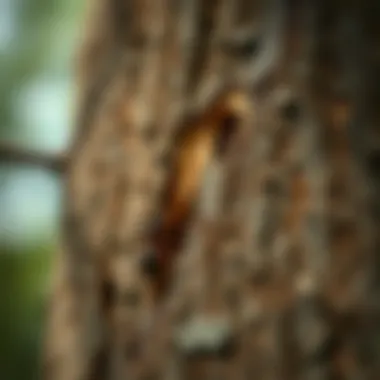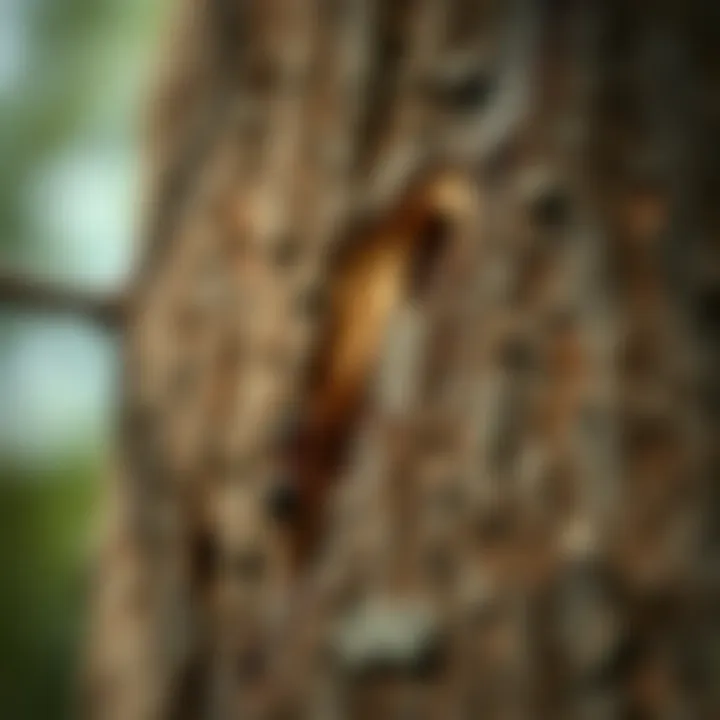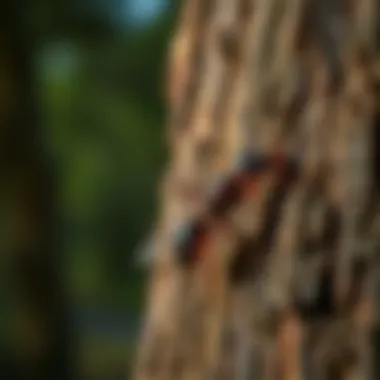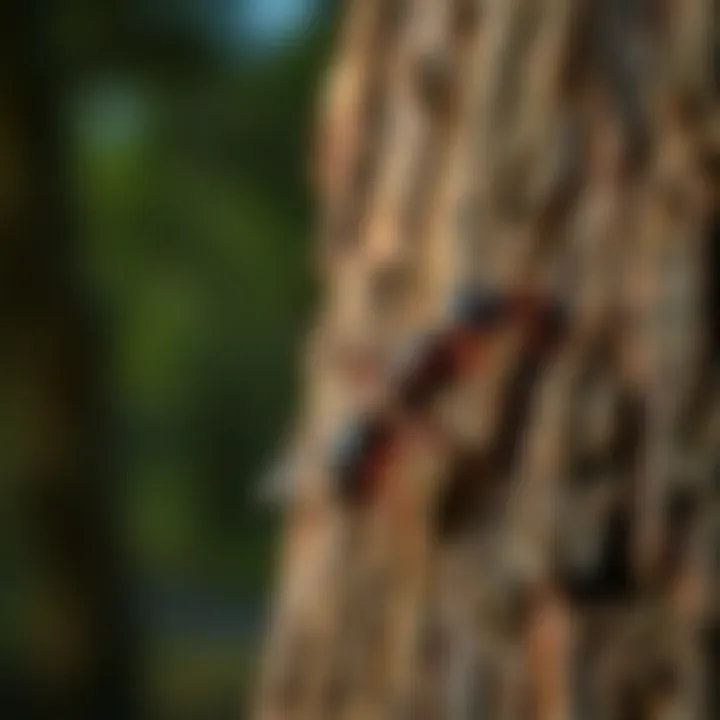Carpenter Ant Tree Damage: Insights and Management


Intro
Carpenter ants are often overlooked due to their small size and seemingly benign nature. However, these creatures play a significant role in altering forest ecosystems, particularly through their activity in trees. Understanding the intricate dance between carpenter ants and their wooden host can illuminate both the immediate impacts on individual trees and the broader consequences for woodland health and biodiversity.
As these ants carve out their nesting sites in decayed wood, they inadvertently open up opportunities for other organisms. Yet, the damage they inflict on living trees can jeopardize forest health. The significance of recognizing and managing carpenter ant populations lies not just in preserving timber quality but also in maintaining the resilience of entire forest systems.
In this article, we'll explore the effects of carpenter ants on trees, addressing their biology, the implications of their behaviors, and effective strategies for managing their presence. The insights here are designed for those who traverse the woods, be it forestry professionals or enthusiastic conservationists, who seek to preserve the vitality of forest ecosystems.
Forest Ecology and Biodiversity
Importance of Forest Ecosystems
Forests serve as a crucial habitat for innumerable species and a vital component of our planet's ecological balance. They contribute significantly to air quality, climate regulation, and soil preservation while also supporting biodiversity. The presence of organisms such as carpenter ants can affect these ecosystems in various ways, both positive and negative. Through their nesting preferences and dietary habits, they influence the decomposition processes that recycle nutrients within the soil, facilitating growth for other plant species. However, this can also lead to detrimental outcomes when they damage healthy trees, thus impacting the canopy structure that provides shelter for many woodland inhabitants.
Flora and Fauna in Woodlands
A diverse assortment of flora and fauna populates the forest landscape. Trees, shrubs, fungi, insects, and animals coexist, each playing their part in the ecological web. Carpenter ants thrive in habitats where decayed wood is abundant, often favoring trees that are already stressed or weakened, like those suffering from disease or drought.
This selective behavior can lead to cascading impacts. For example, when carpenter ants invade a tree, they may provide an entry point for other pests or pathogens. That said, their presence might also attract woodpeckers and other predators, which could help control pest populations but may also lead to further stress on the tree.
"While carpenter ants can serve as agents of decomposition, their destructive tendencies remind us that balance is key within forest ecosystems."
Sustainable Forestry Practices
Techniques for Responsible Management
Effective management of carpenter ant populations is essential for maintaining healthy woodlands. Various strategies can be implemented to mitigate their impacts while promoting an environment where both trees and wildlife thrive. Some recommended techniques include:
- Regular Monitoring: Frequent inspection of trees for signs of carpenter ant activity can help in early detection.
- Maintaining Tree Health: Proper tree care can strengthen individual trees, making them less vulnerable to infestation.
- Habitat Modifications: Removing decayed wood and debris can reduce nesting opportunities for carpenter ants, decreasing their populations after managing existing infestations.
By utilizing these management techniques, forestry professionals can enhance their efforts to ensure sound forest stewardship.
Certification Schemes and Standards
Participating in recognized certification programs, such as those governed by the Forest Stewardship Council or Sustainable Forestry Initiative, can bolster responsible forestry practices. These standards promote ecological health, safeguard biodiversity, and create a framework for sustainable resource management. By adhering to these protocols, organizations can minimize the impact of invasive species, including carpenter ants, while promoting forest resilience.
Community Engagement and Stewardship
Role of Local Communities
Engaging local communities in forest stewardship initiatives can foster a sense of ownership and responsibility towards woodland health. Community members play a critical role in monitoring and managing forests, making them key allies in the struggle against destructive pests like carpenter ants. Through educational programs and workshops, locals can be trained to identify signs of infestation and implement early intervention techniques.
Volunteer Opportunities for Engagement
There are numerous volunteer opportunities available for those eager to make a difference in forest health. Activities such as tree planting, invasive species removal, and awareness campaigns can help communities take an active stance against threats to their woodlands. By collaborating with organizations focused on conservation efforts, individuals can contribute to the protection and enhancement of their local ecosystems, ensuring that they remain vibrant and resilient for generations to come.
Intro to Carpenter Ants and Their Habitat
Understanding carpenter ants and their habitat is crucial for forestry professionals and anyone interested in the health of our woodlands. These insects, while commonly overlooked, play significant roles in forest ecosystems. Their ability to damage trees can lead to not only compromised wood quality but also broader ecological ramifications. When trees suffer, the entire forest suffers, impacting various organisms that rely on these trees for survival. In this section, we will define who carpenter ants are and explore where they thrive, providing a foundational understanding essential for effective management strategies.
Defining Carpenter Ants
Carpenter ants are large black or bicolored ants that can measure up to 0.5 inches long. They belong to the Camponotus genus, which includes over 1,000 species worldwide. Unlike termites, carpenter ants do not consume wood; instead, they excavate it to create their nests. This behavior enables them to thrive in various environments, particularly in damp or decaying wood.
Carpenter ants can be mistaken for other ant species, particularly due to their size and coloration. Adult carpenter ants typically have a smooth thorax with no spines, making identifying them easier when one is familiar with their physical traits. Understanding these details is vital for those in forestry, as early detection can mitigate tree damage significantly.
Natural Habitat and Behavior
Carpenter ants favor moist, decaying environments, primarily trees weakened by disease or damage. Their nests are commonly found beneath the bark or within the heartwood of trees. However, it's not just living trees that attract these ants; they are also drawn to dead or decaying trees, where they can establish colonies readily.
Their behavior exhibits a fascinating social structure. Carpenter ants typically establish colonies that can range from a few hundred to several thousand individuals. Colonies are divided into various roles, with worker ants foraging for food and maintaining the nest, while reproductive members focus on expanding the colony. They often forage at night, seeking sugary substances like honeydew from aphids or food scraps, which can lead them further into human habitats.
Carpenter ant activity can significantly vary with the seasons; during warmer months, they are highly active, while in winter, they go dormant, retreating deeper into their nests to avoid the cold. This seasonal pattern can inform forestry management decisions regarding when to inspect trees and apply preventive measures.
"Carpenter ants are not merely pests; they are remarkable creatures with intricate social behaviors and ecological impacts. Their presence signals the health of our forest ecosystems, making it imperative to understand their habits."
In summary, by grasping the fundamentals about carpenter ants and their habitat, forestry professionals can better safeguard trees and take a proactive stance in managing potential infestations. Understanding these elements is foundational for implementing strategies that can protect our vital natural resources.
The Biology of Carpenter Ants


Understanding the biology of carpenter ants is foundational for tackling their impact on trees and ecosystems. This section dives into their anatomy and reproductive structures, laying the groundwork for recognizing how these ants interact with their environment, particularly in wooded areas. Carpenter ants, as formidable wood-destroying pests, have a complex biological structure that equips them to exploit the very trees that provide their habitat. By appreciating their biology, forestry professionals can devise strategies that not only manage infestations but also contribute to the sustainability of forest resources.
Anatomy of Carpenter Ants
Carpenter ants exhibit a range of anatomical features that distinguish them from other ant species. Typically, they have a robust body, with a dark coloration—often black, red, or a combination of these tones. One discernible trait is their distinctively large mandibles; these are powerful tools used for excavating wood as well as for defense.
- Head: The head of a carpenter ant is large and possesses compound eyes that aid in navigating their environment.
- Exoskeleton: Made of chitin, the exoskeleton is not just a protective layer but also supports their muscular system, allowing for effective movement.
- Abdomen: Notably, the abdomen is segmented and can be distinguished by the absence of a visible pedicel, which sets them apart from termites.
- Wings: While only present in reproductive individuals, wings can be a crucial identifier. During mating season, the alates (winged forms) emerge to establish new colonies.
This unique anatomy not only enables carpenter ants to thrive in their environments but also poses challenges to forestry management. Their ability to chew through wood can lead to structural damage, especially when large colonies establish themselves in trees.
Reproductive Cycle and Colony Structure
The reproductive cycle of carpenter ants is quite intricate. Understanding this cycle is critical for effective management strategies. Carpenter ants typically operate under a social structure that consists of a queen, workers, and, during certain seasons, winged reproductives.
- Colony Structure: A colony usually starts with a single queen, who finds a suitable nesting site in decaying wood or other protected locations. Over time, the colony can grow to thousands of ants, with a division of labor that enhances their efficiency.
- Mating Rituals: In spring and early summer, winged males and females leave the nest for a nuptial flight. After mating, males die, while fertilized queens land, shed their wings, and search for a nesting site to start a new colony.
- Egg Laying: A newly established queen begins laying eggs, which will develop into workers. These workers take on the responsibility of foraging, expanding the nest, and caring for future generations.
- Life Cycle Stages: The life cycle spans various stages—egg, larva, pupa, and adult. The duration of each stage can depend on environmental conditions, such as temperature and food availability.
Understanding these biological elements does more than satisfy academic curiosity; they are crucial for formulating interventions that prevent or control carpenter ant avenues for tree damage.
"By grasping the reproductive cycles and physical structures of carpenter ants, one can discern their behavior patterns and assess the risk they pose to woodlands."
As the interplay between the biology of carpenter ants and tree health becomes clearer, it empowers forestry professionals and enthusiasts alike to engage in more informed, targeted management. This knowledge not only encourages responsible practices but also aids in maintaining the balance of forest ecosystems.
Identifying Carpenter Ant Infestations
Carpenter ants can do quite a number on trees, deeming it essential to spot them early. Knowing how to identify an infestation is the first step to safeguarding trees and ensuring their health. Early detection enables timely intervention, which can help mitigate the extent of the damage they cause. Ignoring signs of these troublesome pests may lead to long-term consequences not only for individual trees but for entire woodlands as well.
Signs of Infestation
Recognizing the signs of a carpenter ant infestation requires attention to detail and a bit of knowledge about their behavior. Here are some key indicators to look out for:
- Sawdust Piles: Unlike regular woodpeckers that peck for their meal, carpenter ants carve out galleries within the wood by excavating it. This often leaves behind small piles of sawdust, which might be found beneath trees or around wood structures.
- Frass: This is a fancy term for the waste material of wood-destroying insects. You might encounter small bits of wood mixed with insect parts if you have an infestation.
- Hollowed Trees: When you knock on a tree trunk, listen. If it sounds hollow, that's not a good sign. Carpenter ants create large tunnels and chambers that weaken the structural integrity of the tree.
- Ant Trails: Keep an eye out for ants marching in a line. Carpenter ants are social insects and tend to follow the same paths when foraging for food. Spotting a line of ants could signal a nearby nest.
- Visible Nests: Sometimes, if you're keen enough, you might spot their nests, especially in damaged wood. Look for small openings where ants enter and leave.
Understanding these signs can help one assess the situation before it spirals into a bigger problem.
Differences Between Carpenter Ants and Termites
A common misconception is that carpenter ants and termites are one and the same. However, distinguishing between these two pests is crucial for effective management. Here’s what sets them apart:
- Body Structure: Carpenter ants have a segmented body with a narrow waist. In contrast, termites carry a more uniform shape, lacking the constricted waist.
- Wings: When in the reproductive stage, carpenter ants have wings that are of different lengths—forewings are larger than their hind wings. Termite wings, however, are typically equal in size and tend to be more fragile, easily broken off.
- Damage: Carpenter ants carve tunnels in wood but do not consume it, while termites eat the wood for sustenance, resulting in more severe structural damage.
- Habitat Preferences: Carpenter ants often prefer moist, decaying wood, typically found in less-traveled areas. Termites are more likely to infest dry, sound wood and remain hidden within structures.
Recognizing these distinctions is vital since it influences the choice of management strategies. Misidentification can lead to ineffective treatment, exacerbating the situation.
By knowing the signs of carpenter ant infestations and how to differentiate them from termites, you can take proactive measures to protect tree health and integrity.
The Impact of Carpenter Ants on Trees
Understanding the effect that carpenter ants have on trees is crucial for anyone involved in forestry or woodland management. These insects are not just a nuisance; they can cause serious, often overlooked damage to trees which can have cascading consequences for entire ecosystems. Recognizing the signs of infestation and the nature of their damage helps in mitigating risks and encouraging healthier forest growth.
Types of Damage Caused by Carpenter Ants
Carpenter ants chiefly harm trees by tunneling through the wood. Unlike termites, which consume the wood, carpenter ants excavate it for nesting purposes. This creates a distinctive pattern of damage:
- Boring tunnels: These cues aren’t just cosmetic; they weaken the structural integrity of the tree, making them more susceptible to breakage during storms or high winds.
- Frass: The dust-like debris from their tunneling can often be spotted beneath infested trees. This frass is made up of wood shavings and ant droppings, signalling a problem when noticed.
- Cankers and decay: Over time, the tunnels can lead to tree decay, which may start a whole chain of issues such as infection by fungi and other pathogens.
In urban areas, the damage can also extend to wooden structures, incurring additional costs in repairs for homeowners. This damage doesn’t just harm single trees; it can also impact the broader ecosystem, affecting wildlife that relies on healthy trees for habitat.
Long-Term Effects on Tree Health
Trees that suffer from carpenter ant infestations tend to show deteriorating health over time. The consequences can be subtle at first, noticeable only through changes in their growth patterns.
- Reduced vigor: Infested trees often grow slower; this decrease in vitality makes them less competitive against other trees, affecting the overall biodiversity of the forest.
- Increased susceptibility to disease: With the outer layers compromised, the tree becomes more vulnerable to pathogens that can lead to further decay, sometimes resulting in tree death.
- Declines in regeneration: Trees that are weakened by carpenter ants may fail to produce seeds or new saplings effectively, resulting in poor forest regeneration.
In summary, the long-term impact on tree health can ripple through the ecosystem. As these trees struggle and sometimes fail, the animals that rely on them for habitat and food may also face dire consequences.
"The presence of carpenter ants is often the tipping point in a decline of tree health that can affect entire woodlands."
As forest stewards, the key lies in understanding these dynamics, as it allows for tailored management interventions that can mitigate long-term damage.
Ecological Considerations of Carpenter Ant Presence


Understanding the role of carpenter ants within their ecosystems is crucial, not only for forest health but also for maintaining biodiversity. These industrious insects are often perceived purely as pests due to their wood-damaging behavior. However, their presence can indicate a range of ecological dynamics. By highlighting the integral aspects of carpenter ants, we can foster a more nuanced appreciation of their ecological significance.
Role in the Ecosystem
Carpenter ants, while notorious for causing damage to trees, are also vital players in forest ecosystems. They serve as both predators and prey, which contributes to the intricate food web. The ants primarily feed on other insects, helping to regulate pest populations that could otherwise defoliate trees or spread diseases. Furthermore, their nesting habits can inadvertently create habitats for other organisms. When carpenter ants excavate wood, they facilitate a process of decay which can support fungi and bacteria that further enhance soil nutrients.
"The balance of nature often hinges on the smallest of creatures; that includes carpenter ants that, despite their destructive tendencies, play a significant role in creating habitat diversity."
In addition to regulating pest populations, the decomposing wood they generate can foster new plant growth. Decayed wood enriches the forest floor, allowing new saplings to thrive. Without carpenter ants, these processes could stall, resulting in an unbalanced ecosystem that may not sustain the diverse wildlife that relies on healthy forests.
Interaction with Other Species
Carpenter ants are woven into the fabric of community interactions in their habitats. Their presence attracts various animal species that rely on them for food. Birds, for instance, hunt them for sustenance, while other insects may scavenge in areas they have altered. The relationships formed between carpenter ants and other species underscore the significance of biodiversity within an ecosystem.
Moreover, the nests of carpenter ants serve as protective environments for many smaller insects that find refuge in the decaying wood. This nesting behavior can be especially beneficial to certain beetle species and other arthropods that depend on such environments for shelter and food.
In essence, while carpenter ants do present management challenges, their ecological impact offers a rich field of interactions and benefits. Acknowledging this complexity enhances our understanding of forest dynamics and encourages holistic approaches to management strategies that respect these creatures while safeguarding trees from excessive damage.
Management Strategies for Carpenter Ant Infestations
Effectively managing carpenter ant infestations is crucial for maintaining the health of wooded areas. These insects can cause significant damage to trees, leading not only to structural weaknesses but also affecting the broader ecosystem. Implementing sound management strategies can significantly mitigate the risks posed by carpenter ants. It helps to preserve trees not just as physical entities but also as vital components of the environment. Setting a proactive approach can save in costs and time later, rendering woodland stewardship a less daunting task.
Preventative Measures in Woodland Stewardship
Preventative measures are the first line of defense against carpenter ant infestations. By emphasizing the significance of maintaining healthy trees, landowners can avoid the conditions that attract these pests. Here are several strategies to consider:
- Tree Maintenance: Regular inspections of trees for signs of damage or disease are imperative. Weak or sick trees are more prone to infestation. Trimming dead branches and removing decaying wood can minimize potential nesting sites.
- Moisture Control: Carpenter ants are particularly drawn to damp environments. Ensuring proper drainage around trees and addressing water pooling issues can reduce their allure.
- Proper Landscaping: Landscaping choices can play a significant role in ant encounters. Keeping mulch layers at a moderate depth and ensuring a distance between wood piles and trees can deter infestations.
- Education and Awareness: Engaging with local forestry groups and accessing resources on woodland stewardship can increase knowledge and empower landowners to take action against invasions.
By integrating these strategies, woodland caretakers can maintain healthier ecosystems, providing a less inviting environment for carpenter ants.
Direct Control Methods
When infestations do occur, direct control methods become essential. There are a variety of techniques that can be effective, including:
- Boric Acid Treatments: Using a boric acid solution can effectively eliminate carpenter ants by affecting their digestive systems. Spraying this solution on targeted areas may require precision, but it generally yields positive results.
- Insecticidal Baits: Setting bait stations around the infested area can attract and kill worker ants. This method allows the bait to be taken back to the colony, gradually reducing the entire population.
- Dust Insecticides: These can be effective in treating voids where ants may reside. Careful application ensures that the dust reaches areas that liquid treatments may not.
Each method presents its unique advantages and challenges. When selecting a control method, it’s crucial to understand the specific dynamics of the infestation and choose accordingly to increase effectiveness.
Professional Pest Management Options
In more severe cases where infestations spread beyond personal control, enlisting professional pest management services might become necessary. Professionals bring expertise and advanced methodologies to the table, ensuring comprehensive solutions. Consider these points when seeking professional aid:
- Assessment: A qualified pest control service will conduct a thorough assessment of the property, identifying the extent of the infestation and the types of carpenter ant species involved.
- Customized Plans: Professionals often develop tailored plans that address the specific needs of the infestation, considering the health of surrounding trees and overall environment.
- Long-Term Monitoring: Beyond immediate treatment, many services offer ongoing monitoring, ensuring any resurgence is caught early. This proactive maintenance is beneficial for preserving the integrity of the forest.
- Safety Standards: Engaging professionals guarantees adherence to safety and environmental standards, minimizing risk to the ecosystem.
Managing carpenter ant infestations involves a multi-faceted approach, blending prevention, direct control, and professional assistance. Effective integration of these strategies can greatly diminish the impact of carpenter ants, safeguarding both trees and ecosystems.
Case Studies of Carpenter Ant Damage
Understanding the influence of carpenter ants on tree health, especially in the context of managed forests and urban settings, is paramount. Case studies serve as a powerful lens into real-world scenarios where these pests have made their mark. They provide insights not only into the extent of the damage caused but also into various management strategies employed to mitigate their impact. By examining different environments and the specific challenges posed, forestry professionals can better arm themselves with knowledge and tactical responses to deal with these formidable insects.
Impact on Managed Forests
Managed forests, often cultivated for timber and biodiversity, are not immune to the effects of carpenter ants. In these environments, the stakes can be quite high, as ant infestations can compromise the integrity of trees and, by extension, the economic viability of forestry endeavors. For instance, there have been documented cases in regions like the Pacific Northwest, where extensive colonies of carpenter ants have been found, causing decay in not only living trees but also harvested timber storages.
Specific Elements of Damage
- Structural Weakness: Carpenter ants hollow out wood to create nesting sites. This can lead to structural instability in mature trees, making them more susceptible to wind damage and decay.
- Decay of Logs: The presence of carpenter ants in logs left for milling can lead to significant losses. In one instance, a managed forest reported that over 30% of their stored timber had to be discarded due to ant-induced deterioration.
- Ecosystem Disruption: Infestations can disrupt the natural balance of ecosystems. As carpenter ants remove parts of trees, they inadvertently create environments that could favor the growth of fungi and other pests, further endangering tree health.
Benefits of Understanding Case Studies
By examining these impacts in managed forests, we can derive valuable lessons on preventative measures and interventions. Here are a few that forestry professionals can utilize:
- Regular Inspections: Implementing routine monitoring can help catch infestations early.
- Integrated Pest Management: Employing a mix of biological controls, like introducing natural predators, can help in managing ant populations without resorting solely to pesticides.
- Community Awareness: Engaging local stakeholders in reporting early signs of infestation can lead to quicker responses, enhancing overall forest health.
Incidents in Urban Areas
Urban environments present a different landscape when it comes to carpenter ant infestations. Here, the presence of these ants can significantly impact not only public perception but also property value. The case of a mid-sized city on the East Coast highlights this aspect well. During a particularly mild winter, an increased number of carpenter ant reports were noted, frequently linked to residential properties.
Specific Considerations for Urban Areas


- Residential Structures: Infestations pinpointed within walls and between floors of homes can lead to costly repairs if not addressed. One report noted that a residential building underwent over $20,000 in repairs after a carpenter ant infestation was discovered behind wooden paneling.
- Tree Canopy Connection: Carpenter ants can easily move from trees into homes by creating bridges from their nesting sites. Trees that are poorly maintained or unhealthy may provide an avenue for the ants to migrate.
- Public Misconceptions: There tends to be a misunderstanding in urban settings that carpenter ants are harmless or just a nuisance. This often leads to delayed action, allowing infestations to grow before more serious damage occurs.
Addressing Urban Incidents
Lessons from urban ant damage incidents emphasize the importance of targeted public education. Here are some key measures:
- Urban Forestry Programs: Promote the health of urban canopy trees through city-led initiatives, reducing the likelihood of infestation.
- Public Outreach Campaigns: Informing citizens about the signs of carpenter ants and the risks associated with infestations can lead to proactive management.
- Access to Professional Help: Encouraging homeowners to seek professional pest control when signs of infestation appear can save significant costs later.
"A stitch in time saves nine." Managing carpenter ant infestations through early detection and targeted intervention can prevent larger, more costly issues down the road.
Public Perception and Awareness
Public awareness and perception play pivotal roles in understanding and managing carpenter ant damage to trees. With the growing interest in forest conservation, misconceptions about these insects can influence how forestry professionals and enthusiasts approach control and management strategies. Raising awareness about carpenter ants' behavior and their ecological significance is essential not only for effective pest management but also for the overall health of forest ecosystems.
Misconceptions About Carpenter Ants
Many people mistake carpenter ants for termites without knowing the distinct differences between the two. Carpenter ants are larger than termites, usually black or bicolored, and they do not consume wood like termites do. Instead, they excavate wood to create nesting sites. This misunderstanding can lead to panic among forest owners, who might overreact and apply inappropriate treatment measures against a supposed termite infestation.
Another common misconception is that carpenter ants are only a problem for dead or dying trees. In reality, they can compromise the structural integrity of healthy trees as well. If left unchecked, the damage they cause can lead to significant long-term effects on tree health and stability. By clarifying these misconceptions, public perception can shift towards a more nuanced understanding of carpenter ants and the strategies needed to manage them effectively.
Promoting Responsible Forest Use
Encouraging responsible forest use involves educating the public about the role of carpenter ants in the ecosystem while highlighting the importance of proactive management strategies. Carpenter ants contribute to forest health by decomposing dead wood, which recycles nutrients back into the soil. However, it's crucial to maintain balance in the forest ecosystem. Encouraging sustainable forestry practices, like selective logging and proper woodland stewardship, can help mitigate the risks associated with carpenter ant infestations.
- Educate about Integrated Pest Management (IPM): Public workshops or online resources can teach about various IPM strategies that consider environmental impacts while managing pests like carpenter ants.
- Promote Healthy Forestry Practices: Items like proper thinning of trees and maintaining tree health can assist in minimizing carpenter ant damage. A healthy forest is more resistant to infestations.
- Foster Community Engagement: Community programs aimed at preserving local forests can be beneficial. Engaging local citizens in projects, including monitoring and reporting carpenter ant activity, can create a sense of ownership and awareness regarding forest health.
"Understanding the true nature of carpenter ants can lead to more informed decisions, protecting both our trees and the delicate balance of our forest ecosystems."
By bridging the gap between misconceptions and responsibility, we can equip communities to approach carpenter ant management thoughtfully and proactively. By fostering an informed public, we take strides towards safeguarding the future of our forests.
Future Research Directions
Research into carpenter ant behavior and management strategies is a pressing necessity, especially as these insects continue to pose threats to forest ecosystems globally. Understanding the intricate dynamics between carpenter ants and the environments they inhabit can lead to more effective methods for managing their populations and mitigating their environmental impact. This section delves into two critical areas of future research: ecosystem interactions and advancements in control methods.
Studies on Ecosystem Interaction
Investigating how carpenter ants interact with their ecosystem is crucial. These interactions can significantly influence forest health and biodiversity. For instance, carpenter ants serve as both predators and prey within their habitats.
- Mutualistic Relationships: Research should focus on their relationships with other species, such as fungi and plants. Understanding how these connections function can shed light on their role in nutrient cycling and forest management.
- Detrimental Effects: Digging into the ecological impacts of carpenter ant infestations can help land managers anticipate changes to forest structure and species composition. The long-term consequences of ant presence on tree vigor or insect populations must be systematically examined.
- Comparative Studies: There is a gap in literature about carpenter ant behaviors across different ecological zones. Utilizing comparative studies could provide insights into how local conditions, like soil type and climate, influence carpenter ant behavior and their impact on trees.
By prioritizing research in these areas, we can develop a more nuanced understanding of the role of carpenter ants in forest ecosystems. This could potentially lead to enhanced conservation strategies that balance ant presence while preserving tree health.
Advancements in Control Methods
Another focal point for future research is the development and refinement of control methods for managing carpenter ant populations. Effective strategies are vital to protect both urban and forested areas from the detrimental effects of these wood-destroying pests.
- Biological Control Techniques: Investigating natural predators or pathogens that may be effective against carpenter ants could provide eco-friendly alternatives to chemical treatments. Examples from similar pest control cases can serve as valuable references here.
- Novel Chemical Avenues: The potential for new insecticides that target carpenter ants specifically while minimizing harm to other species should be explored. Research can focus on non-repellent systems or slow-acting toxins that allow ants to carry the methods back to their colonies, enhancing effectiveness.
- Integrated Pest Management (IPM): Future efforts should integrate research findings into holistic management strategies that consider the ecology of the infestation context. This could involve combining environmental modification, biological controls, and selective chemical usage for a comprehensive approach.
As one contemplates future directions in this research, an emphasis should be placed on collaboration among forestry professionals and researchers. Such partnerships could facilitate field studies and trials essential for ensuring findings are applicable and beneficial in real-world contexts.
"Comprehensive understanding leads to comprehensive action."
In summary, focusing on ecosystem interactions and advancements in control methods not only pushes the field forward but also fosters better stewardship of our forests. The insights gained from these studies can aid in the development of more sustainable practices that preserve the delicate balance within our natural landscapes.
Ending: Integrating Knowledge into Practice
The insights gained from understanding carpenter ants and their impact on trees are crucial for forestry professionals. This conclusion stresses the relevance of applying knowledge effectively to combat the adverse effects these pests can have on timberland and wildlife habitats. Through it, we recognize the interplay of pest management, ecological balance, and sustainable forestry practices.
Incorporating an awareness of carpenter ant behavior and damage patterns can lead to more proactive forest stewardship. It is not merely about eradicating a problem; rather, it's about fostering a healthy ecosystem where trees and wildlife can thrive. Addressing carpenter ant infestations requires an integrated approach that includes monitoring, prevention, and control strategies tailored to specific environments.
Key Benefits:
- Proactive Measures: Awareness allows for timely interventions, which can save trees and reduce long-term damage.
- Ecosystem Health: Understanding pest dynamics contributes to maintaining biodiversity and habitat integrity.
- Economic Savings: Proper management strategies can minimize costs associated with tree replacement and property damage.
This conclusion should resonate with every professional and enthusiast involved in forestry, echoing a shared commitment to preserving forest ecosystems against the looming threat of carpenter ant infestations.
Summary of Key Points
- Carpenter ants pose a significant threat to trees, leading to physical damage and potential tree health issues.
- Their behavior and damage manifestations call for specialized identification and management strategies.
- Early detection and ongoing education are critical in developing effective responses to infestations.
- Collaboration with pest management professionals can enhance control measures and foster woodland health.
Encouragement for Ongoing Education and Vigilance
As we've discussed, the complex relationship between carpenter ants and their forest environments underscores the need for continual learning. The intricacies of pest management, ecology, and tree biology are far-reaching, and staying informed is paramount.
- Participate in Workshops: Engaging in local workshops or webinars can improve understanding of signs of infestation and prevention strategies.
- Follow Research Developments: Keep an eye on recent studies concerning carpenter ant behavior and ecological impacts by accessing resources from academic institutions or government forestry programs.*
- Connect with Peers: Networking with other forestry professionals offers opportunities to share experiences and solutions regarding carpenter ant challenges.
Adopting a proactive stance through ongoing education and vigilance will aid in managing not only carpenter ants but also preserving the richness of our forest ecosystems. The call for responsibility falls upon all of us engaged in the stewardship of our woodlands.















